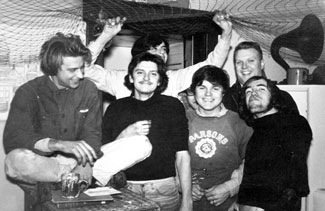In November, Jack invited me to stop by Classic Bike Experience to see, “a really cool bike that might make an interesting post for the shop.”
He explained that the owner was no longer able to ride and wanted the bike sorted out and prepped for sale this winter. When I got there, Jack and Sherb couldn’t wait to tell me all about it; how cool it is, how rare, and all about the vintage bike’s legendary designer, Craig Vetter.
“OMG, Craig Vetter? I went to college with the Vetter brothers.”
The 1973 Triumph X75 Hurricane backstory began in 1966.
It was derived from the BSA Trident and styled by Craig Vetter, a prominent American motorcycle designer who rose to fame in the 1970s with his Windjammer fairings that revolutionized luxury touring bikes.

In 1966, I was there in Champaign, Illinois when the Vetter brothers were among the students studying industrial design in the College of Fine and Applied Arts at the University. They were also hardcore bikers, riding their 2-stroke, blue-smoking Yamahas throughout the winter. I envied them until I broke down and bought my first motorcycle, a BSA Goldstar 500 single. I was always the last to get rolling, kick starting a bike with a compression release and Lucas Prince of Darkness electronics. Craig’s younger brother, Bruce and I were close friends.
He bought his first bike from the local Yamaha dealer, a new 250cc 2-stroke. When Bruce brought it back the very next morning for its 500-mile break-in service, the shop was amazed to see that he had put more than 600 miles on the odometer. “I drove it all day, all night and brought it back whenever they opened in the morning,” he says.
As fall approached, Craig began to fashion a fairing to make it possible to survive the winter chill factor. For the full story with photos, visit the Vetter Fairing page on Craig’s website.
The Triumph X75 Hurricane motorcycle was a unique and very short-lived model.
“In 1968, three years out of design school, I was known for my fairing designs. But I wanted to do an entire motorcycle. At the same time, Don Brown was pondering how to somehow ‘Americanize’ the BSA Rocket 3,” says Craig.
“While returning home from England early in 1969 after seeing the new triples, all I could think of was the bulky appearance of the BSA Rocket 3, those ugly exhaust pipes, and the projected high price,” says Don Brown. “I was certain we were in for a tough time in the marketplace, especially if the inside information about Honda’s new bike was true.”
In late 1969, during a motorcycle trade show in Chicago, Don met Craig Vetter, a young man with long blond hair and a red bandana. He showed Brown a photograph of a sleek motorcycle prototype, which would eventually become the Triumph X75 Hurricane. Brown secretly initiated the design project for the motorcycle Vetter showed him, but BSA’s internal politics derailed his career. Despite BSA’s financial decline and Brown’s departure from the company, Vetter’s design was salvaged and produced in 1973 as the Triumph X75.

Vetter’s Triumph design leaned towards the chopper form with extended forks and a longer wheelbase, but it did not go to any extreme. The X75 Hurricane used the BSA engine with inclined cylinders and had it placed into the BSA frame, creating a distinct look.
One of the most unique features of the X75 Hurricane was its exhaust system, with all three pipes running separately to the right side of the machine, each with a short megaphone-style silencer. This design made the left side look rather bare, but it provided excellent access to the chain case. The motorcycle maintained the conical hub and drum brake from the Trident, along with skimpy mudguards and a one-piece fiberglass molding that enclosed the steel tank and flowed back to form side covers and the seat base.
The X75 Hurricane was built for only one year and featured a unique red paint job with yellow stripes for the fiberglass molding. It was designed for boulevard cruising rather than fast riding, with a short seat and high-rise bars. The model also included light alloy wheel rims and a predominantly chrome finish.
